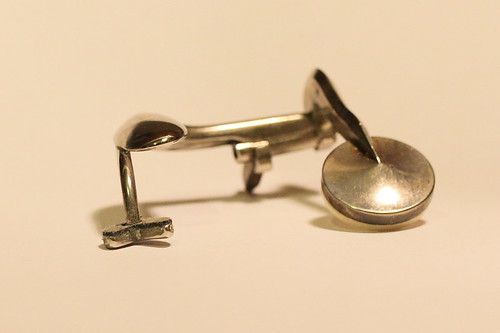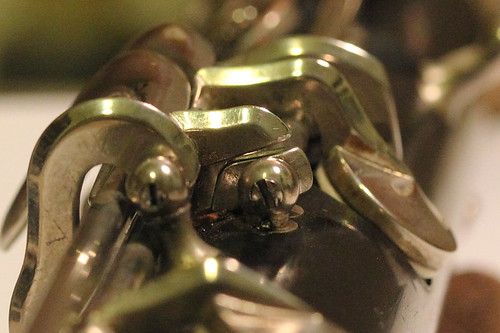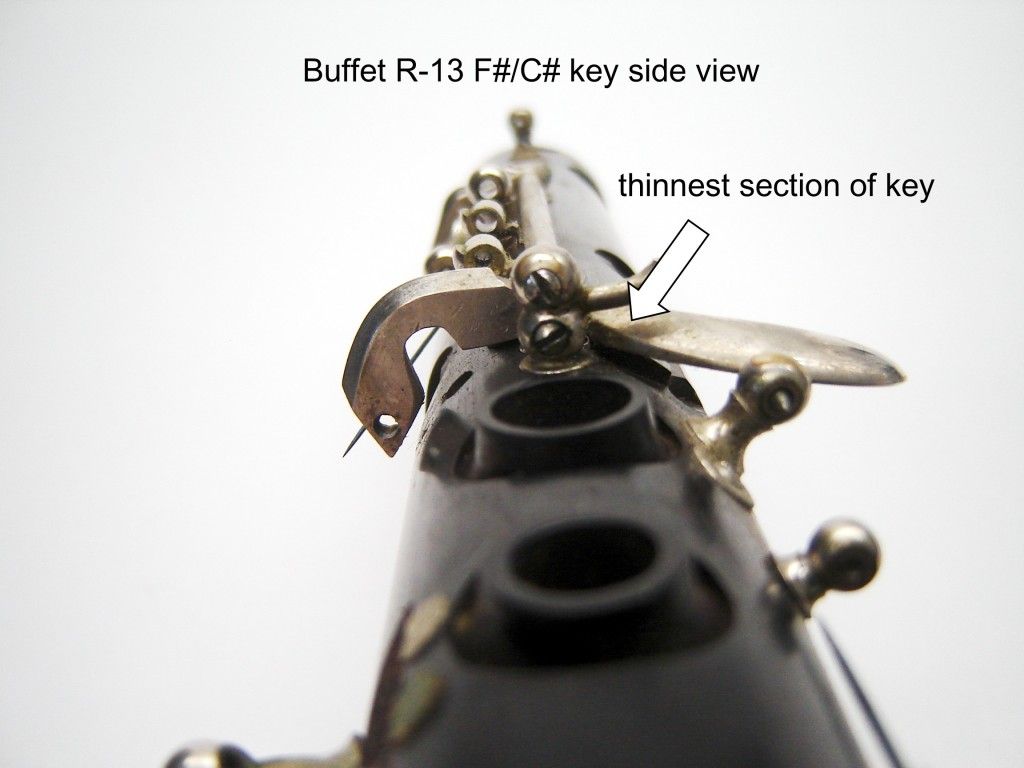I'm just adjusting this area on a clarinet, so I took some photos and can explain my "methods". I use quotes because I don't really follow a specific method that I was taught etc. I use the "method" I described, analyze the mechanism, see if it does what it should, if it can do it better, how best to make it do it better, etc. I imagine a lot of things are pretty similar if not the same as what Steve, John or someones else does. Some things are obviously fast and almost automatic because you've done it many times, but in general this is the approach I use for every adjustment including this one. So this is an example, FWIW...
First is the Ab/Eb key. I glued a material that I prefer and with more than "necessary" size for the reason descriped in a previous post. The thickness of the material here is determined by the position of the key. It's essentially like thickening the touchpiece itself. So the thickness is chosen to put the touchpiece at the best height when open/close with the amount of key opening I want. If a "too thick" material is required then I bend (call it align or straighten if you prefer) whatever part that is necessary (touchpiece, key, stop post) to allow the key to use the thickness I prefer. This will give the position I want with the thickness of material I want.

Pretty much the same for the crow's foot. I use the material and thickness I consider best for this situation. In this case thin synthetic felt, because it's a good anf firm material for this adjustment but also pretty quiet (quieter than rubber-cork/tech-cork). Same as the Ab/Eb key, if a too thick or too thin material is necessary then (if possible, almost always is) I align the parts so the material I want will work.
The following photo doesn't really show it but after this, when F/C, F#/C# and E/B were on the clarinet, there was double action between the E/B touchpiece and the crow's foot.
Sometimes the F/C key will hit its LH lever linkage first, but this is not the case here because 1) this linkage doesn't have its material glued to it yet and 2) the crow's foot is touching the F#/C# touchpiece, just not the E/B touchpiece.
So there are two options. Loweing the E/B touchpiece or raising the F#/C# touchpiece.
The former can be done by John's "quick and dirty trick"

(which is as good as any method!) or by adding (replacing with thicker) material to the bumper of the E/B key (shown in next photo). IMO replacing the cork and sand to thickness has no advantage. It's significantly slower and is not more accurate, often less (one extra slide of the sander or pressing a fraction too much with and it's too late and need to be done all over again). Bending here will not damage anything. It is so much faster and at least as precise if not more.
The latter can't be done by the "quick and dirty trick", as explain in my previous post. The next photo shows how the F#/C# key linkage arm has no bumper and is not touching the body, so raising or lowering this part (in relation to the touchpiece) will have no effect on its (the touchpiece) height. The bumper here is the pad itself, so the touchpiece needs to raise in relation to the key (pad). Either raising the touchpiece itself or raising the key would work, though often it's a combination and when bending in this it is the hinge rod that will twist. Regardless, it will work accurately with no issues.

There is one main difference between the two methods. Lowering the E/B touchpiece (and its key with it, though this doesn't matter for now) will do nothing except that. Raising the F#/C# touchpiece will also lower the F/C linkage arm that is resting against the linkage from the F/C LH lever. I wanted them to be closer regardless, so I chose the latter method, which also put the F/C lnkage arm in a good position. It is possible to lower this linkage arm in relation to the F/C key and touchpiece, but is more difficult. It is easier to raise both E/B and F#/C# touchpieces to achieve the same thing. The difference is the position of the touchpieces, but often the differences are so small that any reason other than using the simplest method (i.e. easiest to achieve accuracy) is insignificant.
The next photo shows the F/C key to lever linkage. On many clarinets, including this one, there are mainly two problems.
First, the design of the linkage itself is not great. Optimally it should work like gear teeth. It's sometimes possible to make it this way but usually requires very dastic changes that are rarely worth the effort. This will have the least friction between the linkage arms.
Second, the operating arm has a corner that raises the key. This digs into the material glued to the key side the linkage, which can eventually cause noise, double action, etc.
Another issue that is that often a poor choice of material is used. In this case regular cork was used and was completely chewed by the corner.
I smoothed the corner to have a small curve. Be careful not to curve it too much. Because the corner (now curve) is the part actually touching the other side of the linkage when pressed, curving too much will make the travel too long and uncomfortable to play. The photo shows the curved corner and also the linkage before F#/C# was raised to also allow a smaller gap.
I prefer to use a thin material here, usually up to 0.5mm. What I like best for this is synthetic microfiber imitation leather which is just under 0.3mm. This material is incredibly quiet for its thickness (I often use it under throat G# adjustment screws). In this case this material was just slightly too thin, so I used a part of a 0.3mm rubber-cork (aka tech-cork) that was actually much thinner, under 0.2mm (just from uneveness of the material) and glued the microfiber over it.
One problem is where the gap here is too big even after adjusting the keys to reduce it as much as possible (by raising F/C LH lever and raising F/C key). I don't like to use a thicker material for this unless it's a cheap budget repair. Sometimes I solder a small silver sheet using tin/silver solder, or just add tin/silver solder to the linkage and shape it (it's pretty fast).
Maybe this will give some ideas.








